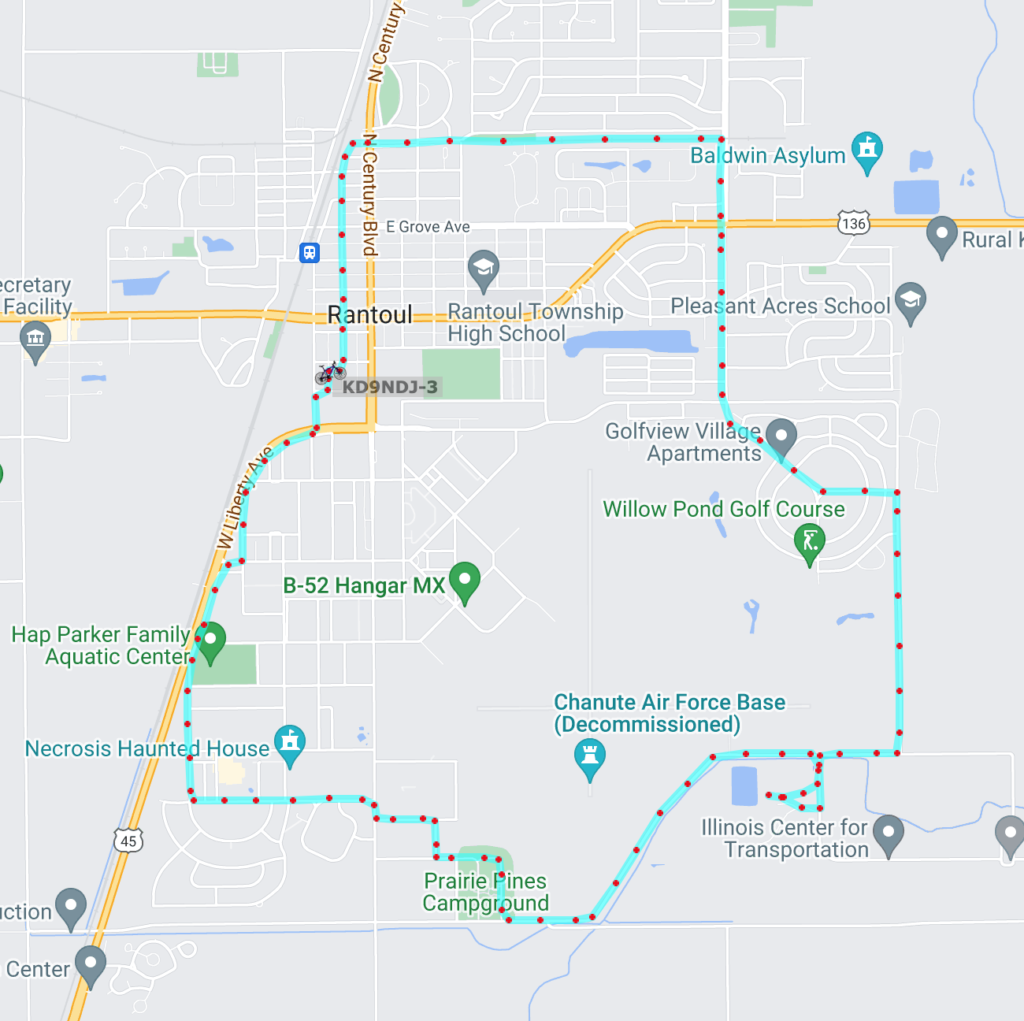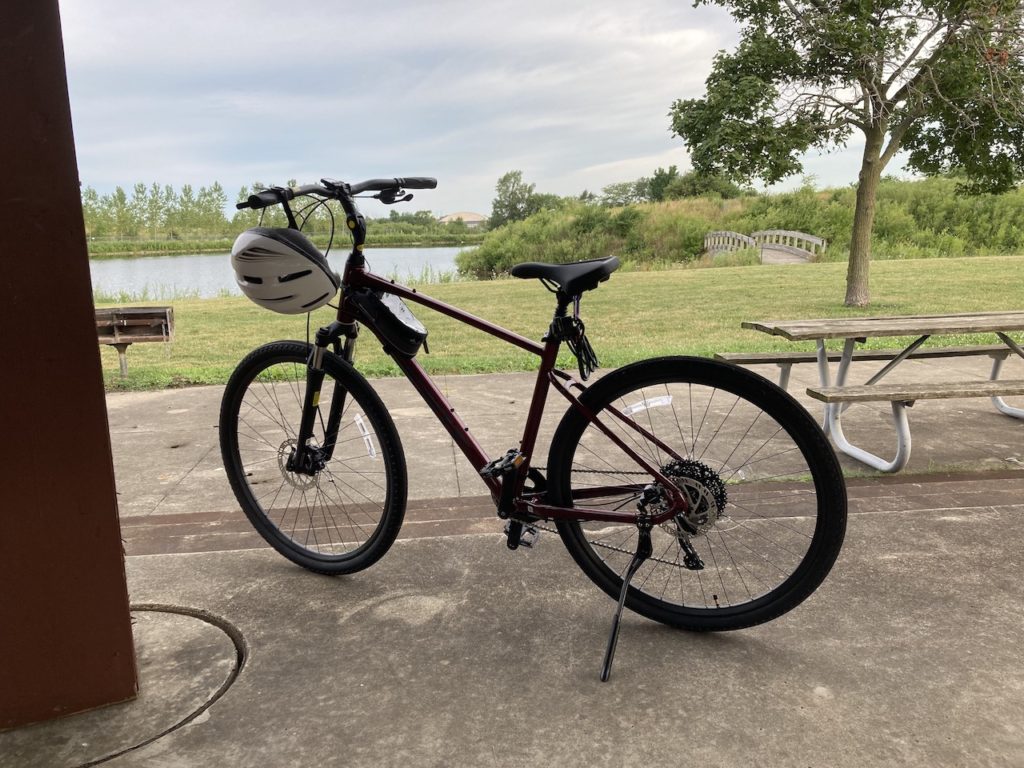Just back from my first ride on a new bicycle. Earlier, I wrote a little about my experience visiting three local bike shops. I got as far as Durst Cycles and Fitness, and visited both locations. Yesterday, July 22, I went back to the Urbana shop, long familiar to me, on University Avenue. I had hoped they’d let me try out the Giant Cypress models I’d been looking at online. As it turned out, they did all that and more. I rode three bikes multiple times, not just around the parking lot, but over the railroad tracks and down the bike path. The three were: the Giant Cypress 2, the Giant Cypress 3, and the Liv Momentum Vida. They were all very similar, but the subtle differences were what I focused on. Most interesting in feel was the Vida. It’s more of a comfort bike than the Cypress models, and this was my first ride on such a bike. The cassette, the Shimano Altus CS-HG31, has 8 sprockets ranging from 11 to 34 teeth. I wasn’t able to get enough range and variety of topography to try each sprocket. The frame geometry on the Vida was easy on the testicles, and the reach was about right.
All good.
But I rode the Cypress 2 again, and decided that this was the winner. The microSHIFT Advent, with a sprocket range of 11 to 46 teeth, makes potential climbs a bit more doable. I have not looked in to potential mods yet, of course. Another factor was the adjustable stem, which makes it possible to get the handlebars where I really want them. Higher. The hydraulic disc braking is so far superior to anything I’ve been accustomed to. That, despite the likely pain in the butt factor when it comes to wheel maintenance, plus the aforementioned, meant I was sold.
So I bought the bike, strapped it to the rack on the truck, and brought it home.
On the first outing this morning, I notice that it needs some derailleur adjustment: the bike won’t track on the 11 tooth sprocket. I noticed this on the downhill slope of the familiar rail trail up top of Garrard Street, where the slope takes you down to Maplewood. I had spent a bit of time last evening, before SBR 25, installing a Trek bike computer that had been laying around here unused since we bought this house. New in the box! I batteried it up, strapped that bad boy on, and did a hasty calibration given the wheel size. Not terrible accurate, but probably in the ballpark. So I was getting to a whopping 15 (alleged) mph, and just could NOT get the chain to stay put. But I get some service and adjustment for awhile. The advantage of bike shops, eh, Christoper Cullen, oh, nephew o’ mine?
More later… but I wanted to get this logged…
Here is the advertised later (7-25-2022)…


I noticed while snapping the photo that the rear chain guard has gone askew… that might be from transporting the bike and could account for the difficulty with getting into the 11 tooth sprocket. Before setting off again, I repositioned that sucker. Easy to do. A bit too easy, if you ask me. Is it worth keeping on there? Maybe not. Got a chance, on the big slope up to the lake, to try the 46 tooth sprocket. Again, the limit is not quite correct. That might be what knocked the guard off center!
Other little tweaks: the saddle needs to go up and back a bit. The up part is easy. But the back part, as well as the angle, takes (oh no! not that!) an allen key. Taking notes for my, uh, slave staff mechanic down at Durst.
In any event… it’s a fun bike to ride.
Ah yes. Derailleur limit screws and hanger alignment. If you’re having trouble getting in the fastest gear, (11 tooth in your case) it’s possible that all that’s needed is about a quarter turn of the high limit screw. (which are sometimes Allen heads rather than Phillips but either way) If you unscrew the high limit it should allow the chain line to get into the lowers gears properly. But watch out because too much freedom with the high limit will cause the chain to come off completely and begin to rub the frame. Too much freedom with the low limit and your chain can fall off the lowest gear (easiest to pedal) and get into the spokes. Limit screws are there to put a stopping point on the chain line to prevent either of these two outcomes. Small adjustments to limit screws will move the chain line quite a bit so tread lightly. And if all of this still doesn’t help you might be dealing with a bent derailleur hanger which happens more than most people might think and does require help from a bike shop and a hanger alignment tool. Congratulations on the new whip and I hope you have fun riding it and learning your way around all new technology. PS disc brakes should actually involve less maintenance with the wheels. The term “disc true” is thrown around at a lot of shops when truing wheels with disc brakes. Basically means “good enough” and this is because the rim no longer needs to be perfect in order for the brakes to work properly.
Sorry need to edit last comment… high and low gears can be confusing terminology.
If you can imagine your cassette is laid flat on a table stacked in order with the smallest tooth cogs on top it would look like a mountain.
Low gears would be the bottom of the mountain and high gears are the top.
Thus the derailleur has two limit screws side by side each other and most are labeled “H” for high and “L” for low.
So the 46tooth is where the low limit screw needs to be adjusted to allow the chain to get there but not beyond there and the high limit is for your 11tooth cog.
Now you need to calculate the gear inches and graph them, just to geek out totally. Otherwise, what Chris said. Congrats on the new ride.